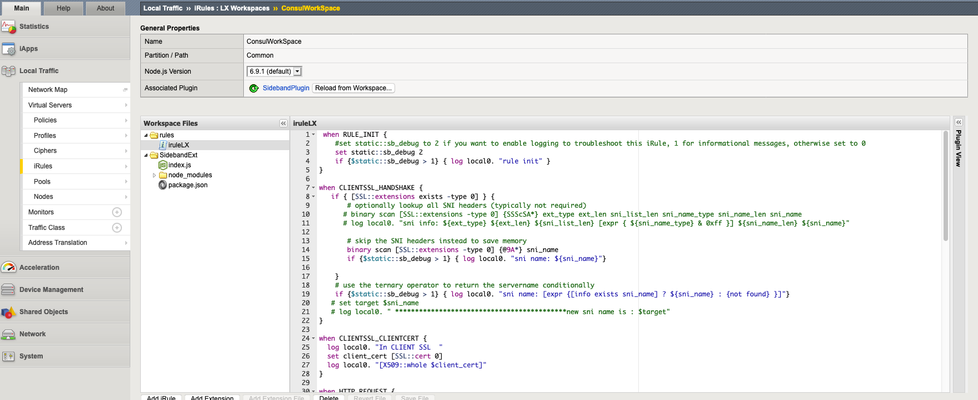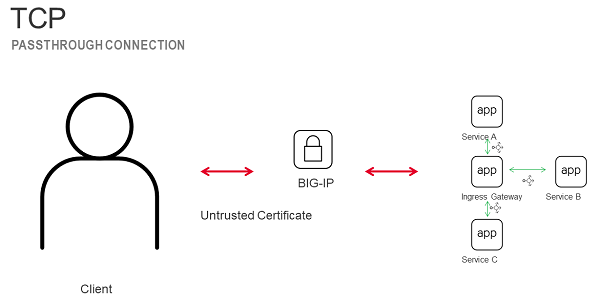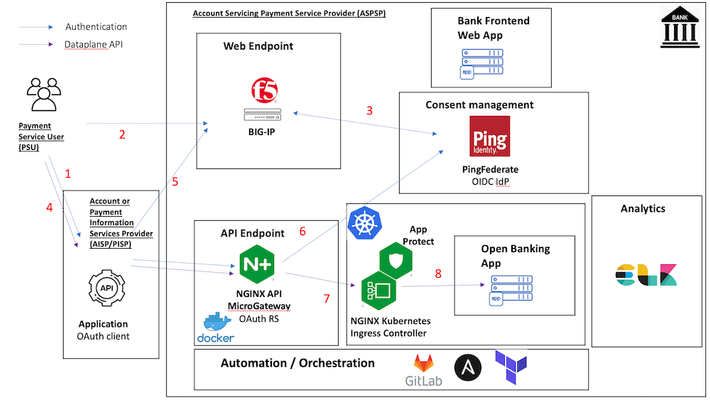mtls
4 TopicsF5 BIG-IP as a Terminating Gateway for HashiCorp Consul
Our joint customers have asked for it, so the HashiCorp Consul team and the F5 BIG-IP teams have been working to provide this early look at the technology and configurations needed to have BIG-IP perform the Terminating Gateway functionality for HashiCorp Consul. A Bit of an Introduction HashiCorp Consul is a platform that is multi cloud and is used to secure service to service communication. You have all heard about microservices and how within an environment like Consul there is a need to secure and control microservice to microservice communications. But what happens when you want a similar level of security and control when a microservice inside the environment needs to communicate with a service outside of the environment. Enter F5 BIG-IP - the Enterprise Terminating Gateway solution for HashiCorp. HashiCorp has announced the GA of their Terminating Gateway functionality, and we here at F5 want to show our support for this milestone by showing the progress we have made to date in answering the requests of our joint customers. One of the requirements of a Terminating Gateway is that it must respect the security policies defined within Consul. HashiCorp calls these policies Intentions. What Should You Get Out of this Article This article is focused on how BIG-IP when acting as a Terminating Gateway can understand those Intentions and can securely apply those policies/Intentions to either allow or disallow microservice to microservice communications. Update We have been hard at work on this solution, and have created a method to automate the manual processes that I had detailed below. You can skip executing the steps below and jump directly to the new DevCentral Git repository for this solution. Feel free to read the below to get an understanding of the workflows we have automated using the code in the new DevCentral repo. And you can also check out this webinar to hear more about the solution and to see the developer, Shaun Empie, demo the automation of the solution. First Steps Before we dive into the iRulesLX that makes this possible, one must configure the BIG-IP Virtual server to secure the connectivity with mTLS, and configure the pool, profiles, and other configuration options necessary for one's environment. Many here on DevCentral have shown how F5 can perform mTLS with various solutions. Eric Chen has shown how to configure the BIG-IP to use mTLS with Slack. What I want to focus on is how to use an iRuleLX to extract the info necessary to respect the HashiCorp Intentions and allow or disallow a connection based on the HashiCorp Consul Intention. I have to give credit where credit is due. Sanjay Shitole is the one behind the scenes here at F5 along with Dan Callao and Blake Covarrubias from HashiCorp who have worked through the various API touch points, designed the workflow, and F5 Specific iRules and iRulesLX needed to make this function. Now for the Fun Part Once you get your Virtual Server and Pool created the way you would like them with the mTLS certificates etc., you can focus on creating the iLX Workspace where you will write the node.js code and iRules. You can follow the instructions here to create the iLX workspace, add an extension, and an LX plugin. Below is the tcl-based iRule that you will have to add to this workspace. To do this go to Local Traffic > iRules > LX Workspaces and find the workspace you had created in the steps above. In our example, we used "ConsulWorkSpace". Paste the text of the rule listed below into the text editor and click save file. There is one variable (sb_debug) you can change in this file depending on the level of logging you want done to the /var/log/ltm logs. The rest of the iRule Grabs the full SNI value from the handshake. This will be parsed later on in the node.js code to populate one of the variables needed for checking the intention of this connection in Consul. The next section grabs the certificate and stores it as a variable so we can later extract the serial_id and the spiffe, which are the other two variables needed to check the Consul Intention. The next step in the iRule is to pass these three variables via an RPC_HANDLE function to the Node.js code we will discuss below. The last section uses that same RPC_HANDLE to get responses back from the node code and either allows or disallows the connection based on the value of the Consul Intention. when RULE_INIT { #set static::sb_debug to 2 if you want to enable logging to troubleshoot this iRule, 1 for informational messages, otherwise set to 0 set static::sb_debug 0 if {$static::sb_debug > 1} { log local0. "rule init" } } when CLIENTSSL_HANDSHAKE { if { [SSL::extensions exists -type 0] } { binary scan [SSL::extensions -type 0] {@9A*} sni_name if {$static::sb_debug > 1} { log local0. "sni name: ${sni_name}"} } # use the ternary operator to return the servername conditionally if {$static::sb_debug > 1} { log local0. "sni name: [expr {[info exists sni_name] ? ${sni_name} : {not found} }]"} } when CLIENTSSL_CLIENTCERT { if {$static::sb_debug > 1} {log local0. "In CLIENTSSL_CLIENTCERT"} set client_cert [SSL::cert 0] } when HTTP_REQUEST { set serial_id "" set spiffe "" set log_prefix "[IP::remote_addr]:[TCP::remote_port clientside] [IP::local_addr]:[TCP::local_port clientside]" if { [SSL::cert count] > 0 } { HTTP::header insert "X-ENV-SSL_CLIENT_CERTIFICATE" [X509::whole [SSL::cert 0]] set spiffe [findstr [X509::extensions [SSL::cert 0]] "Subject Alternative Name" 39 ","] if {$static::sb_debug > 1} { log local0. "<$log_prefix>: SAN: $spiffe"} set serial_id [X509::serial_number $client_cert] if {$static::sb_debug > 1} { log local0. "<$log_prefix>: Serial_ID: $serial_id"} } if {$static::sb_debug > 1} { log local0.info "here is spiffe: $spiffe" } set RPC_HANDLE [ILX::init "SidebandPlugin" "SidebandExt"] if {[catch {ILX::call $RPC_HANDLE "func" $sni_name $spiffe $serial_id} result]} { if {$static::sb_debug > 1} { log local0.error "Client - [IP::client_addr], ILX failure: $result"} HTTP::respond 500 content "Internal server error: Backend server did not respond." return } ## return proxy result if { $result eq 1 }{ if {$static::sb_debug > 1} {log local0. "Is the connection authorized: $result"} } else { if {$static::sb_debug > 1} {log local0. "Connection is not authorized: $result"} HTTP::respond 400 content '{"status":"Not_Authorized"}' "Content-Type" "application/json" } } Next is to copy the text of the node.js code below and paste it into the index.js file using the GUI. Here though there are two lines you will have to edit that are unique to your environment. Those two lines are the hostname and the port in the "const options =" section. These values will be the IP and port on which your Consul Server is listening for API calls. This node.js takes the three values the tcl-based iRule passed to it, does some regex magic on the sni_name value to get the target variable that is used to check the Consul Intention. It does this by crafting an API call to the consul server API endpoint that includes the Target, the ClientCertURI, and the ClientCertSerial values. The Consul Server responds back, and the node.js code captures that response, and passes a value back to the tcl-based iRule, which means the communication is disallowed or allowed. const http = require("http"); const f5 = require("f5-nodejs"); // Initialize ILX Server var ilx = new f5.ILXServer(); ilx.addMethod('func', function(req, res) { var retstr = ""; var sni_name = req.params()[0]; var spiffe = req.params()[1]; var serial_id = req.params()[2]; const regex = /[^.]*/; let targetarr = sni_name.match(regex); target = targetarr.toString(); console.log('My Spiffe ID is: ', spiffe); console.log('My Serial ID is: ', serial_id); //Construct request payload var data = JSON.stringify({ "Target": target, "ClientCertURI": spiffe, "ClientCertSerial": serial_id }); //Strip off newline character(s) data = data.replace(/\\n/g, '') ; // Construct connection settings const options = { hostname: '10.0.0.100', port: 8500, path: '/v1/agent/connect/authorize', method: 'POST', headers: { 'Content-Type': 'application/json', 'Content-Length': data.length } }; // Construct Consul sideband HTTP Call const myreq = http.request(options, res2 => { console.log(`Posting Json to Consul -------> statusCode: ${res2.statusCode}`); res2.on('data', d => { //capture response payload process.stdout.write(d); retstr += d; }); res2.on('end', d => { //Check response for Valid Authorizaion and return back to TCL iRule var isVal = retstr.includes(":true"); res.reply(isVal); }); }); myreq.on('error', error => { console.error(error); }); // Intiate Consul Call myreq.write(data); myreq.end(); }); // Start ILX listener ilx.listen(); This iRulesLX solution will allow for multiple sources to connect to the BIG-IP Virtual Server, exchange mTLS info, but only allow the connection once the Consul Intentions are verified. If your Intentions looked something similar to the ones below the Client microservice would be allowed to communicate with the services behind the BIG-IP, whereas the socialapp microservice would be blocked at the BIG-IP since we are capturing and respecting the Consul Intentions. So now that we have shown how BIG-IP acts as terminating Gateway for HashiCorp Consul - all the while respecting the Consul Intentions, What’s next? Well next is for F5 and HashiCorp to continue working together on this solution. We intend to take this a level further by creating a prototype that automates the process. The Automated prototype will have a mechanism to listen to changes within the Consul API server, and when a new service is defined behind the BIG-IP acting as the terminating Gateway, the Virtual server, the pools, the ssl profiles, and the iRulesLX workspace can be automatically configured via an AS3 declaration. What Can You Do Next You can find all of the iRules used in this solution in our DevCentral Github repo. Please reach out to me and the F5 HashiCorp Business Development team here if you have any questions, feature requests, or any feedback to make this solution better.1.1KViews3likes0Comments3 Ways to Connect BIG-IP to Istio
Istio, a service mesh, uses “zero trust” to authenticate services. We’ll look at 3 ways to connect BIG-IP to Istio. 1. TCP The first method that we will use will be TCP. This will allow the BIG-IP to passthrough client traffic to Istio’s Ingress Gateway. 2. Mutual TLS (mTLS) The second method is to use the Client Certificate Constrained Delegation (C3D) feature of BIG-IP to authenticate client connections via mTLS and then generate a new client certificate (with similar attributes to the original) and use that newly minted certificate to authenticate to Istio. This second example is useful for scenarios where you are unable to install a trusted (externally CA signed) certificate into Istio (corporate policy prohibits it) and/or you want to establish a TLS DMZ. Despite the connection using mTLS the BIG-IP can inspect the traffic (i.e. log to Splunk), apply policy (i.e. insert XFF headers, WAF protection), etc… 3. JSON Web Tokens (JWT) Istio can use JWT tokens to authenticate users, but not all enterprise systems speak JWT. Using BIG-IP Access Policy Manager (APM) we can create an access policy that performs Single-Sign On (SSO) with an OAuth bearer token (JWT). This enables us to authenticate a client with username / password and convert the identity into a JWT token that is understood by Istio. Video Please These 3 methods are discussed and demo’d in the following YouTube video. Thanks for reading/watching!2.5KViews2likes2CommentsConfiguring NGINX API micro-gateway to support Open Banking's Advanced FAPI security profile
Introduction In my last article, Integrating NGINX Controller API Management with PingFederate to secure financial services API transactions, we have seen how to configure NGINX Controller to perform basic JWT authorization against PingFederate, configured as OIDC IdP / OAuth Autorization Server. One weakness of the basic JWT authentication mechanism is the lack of context: anyone presenting a valid JWT will be allowed to performed the actions granted by the token, even if the sender is not the original OAuth client that was issued the token. This opens an avenue for attackers to use JWTs stollen from their rightful owners. Ideally, a mechanism of restricting the usage of the JWT to their original requestor is needed and this type of protection is specifically required for API calls presenting the highest risk, such as financial API calls. For example, Financial-grade API (FAPI) Security Profile 1.0 - Part 2: Advanced (Read and Write API Security Profile) specifies that: Authorization server: shall only issue sender-constrained access tokens; shall support MTLS as mechanism for constraining the legitimate senders of access tokens; Uncertainty of resource server handling of access tokens The protected resources that conform to this document shall not accept a bearer access token. They shall only support sender-constrained access tokens via MTLS. It is therefore useful to examine the configuration of NGINX, in its micro-gateway deployment mode, needed to perform the function of a resource server in cases requiring the Advanced FAPI security profile. Setup A high-level diagram of the lab environment used to demonstrate this setup is found below: The roles performed by each network element are described below: Authentication and API flow The workflow is very similar with the one described in my last article, with the differences highlighted here in bold: The user logs into the Third Party Provider application ("client") and creates a new funds transfer The TPP application redirects the user to the OAuth Authorization Server / OIDC IdP - PingFederate The user provides its credentials to PingFederate and gets access to the consent management screen where the required "payments" scope will be listed If the user agrees to give consent to the TPP client to make payments out of his/her account, PingFederate will generate an authorization code (and an ID Token) and redirect the user to the TPP client The TPP client opens an MTLS connection to the IdP, authenticates itself with a client certificate, exchanges the authorization code for a user-constrained access token and attaches it as a bearer token to the /domestic-payments call sent to the API gateway over an MTLS session authenticated with the same client certificate The API Gateway terminates the MTLS session and obtains the client certificate, authenticates the access token by downloading the JSON Web Keys from PingFederate, checks the hashed client certificate matches the value found in the token and grants conditional access to the backend application The Kubernetes Ingress receives the API call and performs WAF security checks via NGINX App Protect The API call is forwarded to the backend server pod Examining the differences between the workflows, it becomes apparent the extra actions NGINX API micro-gateway has to perform to support this advanced security use case are MTLS termination and client certificate hash verification. NGINX API micro-gateway configuration The full configuration is available on DevCentral's Code Share: Configure NGINX microgateway for MTLS termination and client certificate hash verification I will highlight below the most relevant parts of the configuration. MTLS termination server { server_name api.bank.f5lab; listen 443 ssl; ssl_certificate /etc/nginx/f5lab.crt; ssl_certificate_key /etc/nginx/f5lab.key; ssl_session_cache off; ssl_prefer_server_ciphers off; ssl_client_certificate /etc/nginx/updated_ca.crt; ssl_verify_client on; ssl_verify_depth 10; A detailed explanation of each of these commands can be found in the ngx_http_ssl_module user guide. JWT client certificate hash verification To compute and validate the client certificate hash, we will use an njs script (more information on njs scripting language and installation process can be found here). The njs script used (named "x5t.js" in our case) is shown below: function validate(r) { var clientThumbprint = require("crypto") .createHash("sha256") .update(Buffer.from(r.variables.ssl_client_raw_cert.replace(/(\n|----|-BEGIN|-END| CERTIFICATE-)/gm, ''), 'base64')) .digest("base64url"); return clientThumbprint === r.variables.jwt_cnf_fingerprint ? '1' : '0'; } export default { validate } Importing the "x5t.js" script in the main nginx configuration is done by: js_import /etc/nginx/x5t.js; We are populating the value of variable $jwt_cnf_fingerprint (available to the njs script via "r.variables.jwt_cnf_fingerprint") by extracting the 'x5t#S256' value from JWT: auth_jwt_claim_set $jwt_cnf_fingerprint 'cnf' 'x5t#S256'; The "validate" function of "x5t.js" will the compare the value of $jwt_cnf_fingerprint variable extracted from JWT with the computed SHA256 hash of the client certificate and set the validation result in the $thumbprint_match variable. js_set $thumbprint_match x5t.validate; Lastly, we will make a decision to accept or block client's access based on the validation result: if ($thumbprint_match != 1) { return 403 'Access denied because client SSL certificate thumbprint does not match jwt_cnf_fingerprint'; } Conclusion Supporting MTLS termination and client certificate hash validation against sender-constrained JWTs issued by Authorization Servers such as PingFederate, enables NGINX API micro-gateway to support Open Banking's Advanced FAPI security profile. Resources The UDF lab environment used to build this configuration can be found here.2.2KViews1like0Comments


